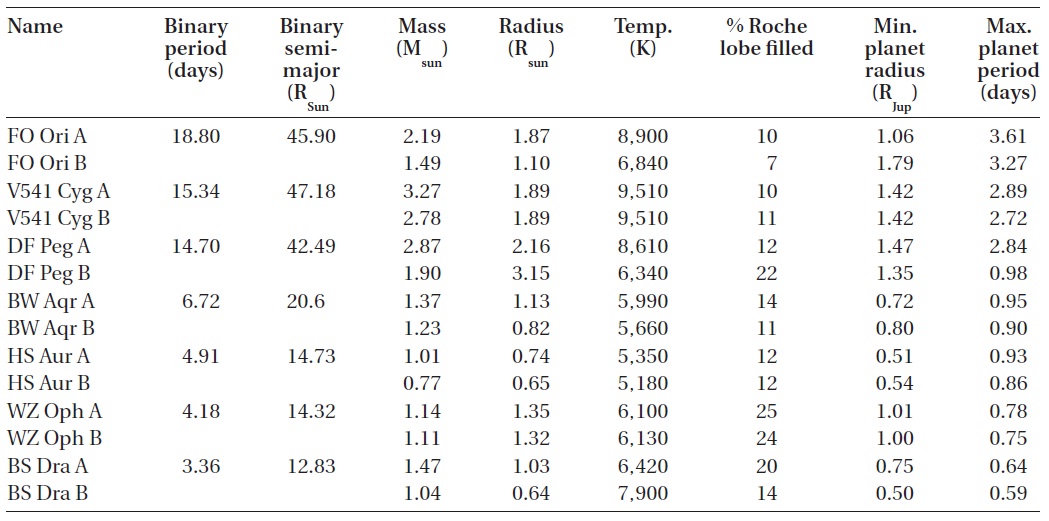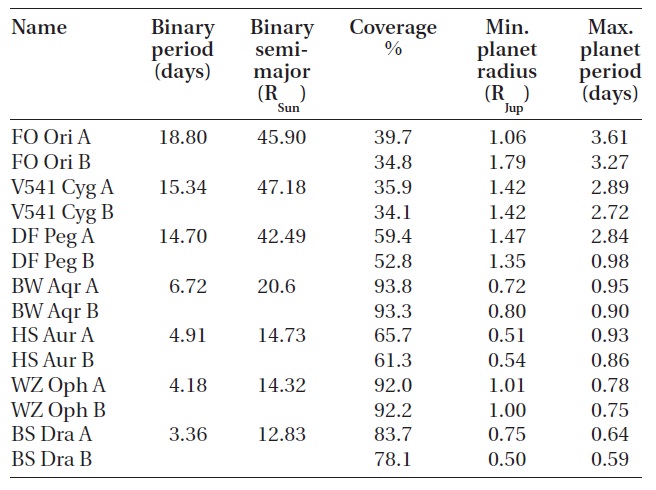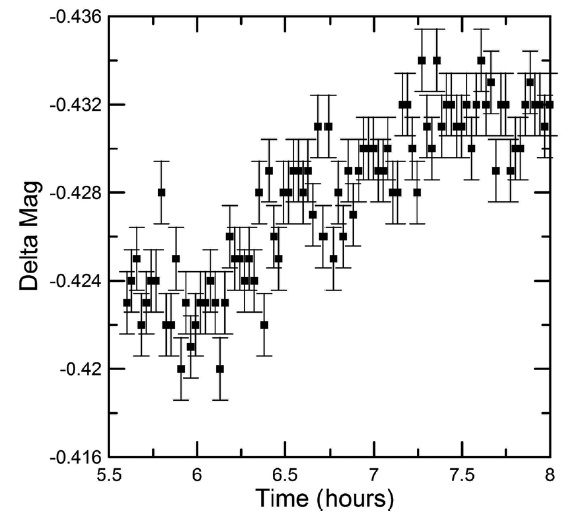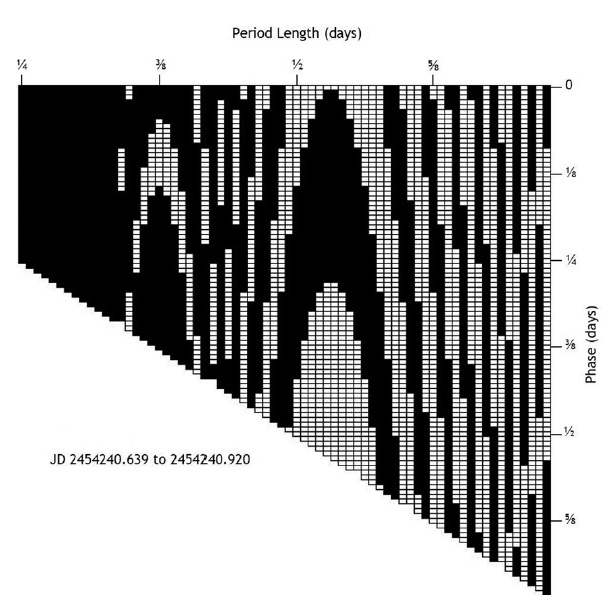



As of this writing the number of confirmed exoplanets exceeds 700. However, the number of exoplanets known in binary star systems is far less. Only a small number of binaries with planets are known. Most of these planets are in wide binaries with stellar orbital periods of de-cades or longer. The planets can be either circumbinary (P-type) or circumstellar (S-type). In the former case the planet orbits at such a great distance that the stars are ef-fectively a single point mass. An exception is the recently discovery, Kepler 16b (Doyle et al. 2011). It has the small-est orbital distance yet found for a P-type orbit; just 0.7 AU. Most of the known binaries with planets are S-type systems. These are wide binary star systems where the planet’s orbit about its host star is largely unaffected by the distant companion star. An example is γ Cep where the stellar orbital period is 57 years.
The existence of planets in binary star systems chal-lenges and tests models of planet formation. Currently, the formation of planets in binary stars is modeled by ei-ther the core accretion theory or disk instability theory. In the case of S-type orbits the protoplanetary disk sur-rounding one star is tidally and thermally perturbed by the companion star. Theoretical studies have indicated that planet formation may be impossible if the stars are closer than 20-100 AU (Eggenberger & Udry 2010). But γ Cep (Campbell et al. 1988), and HD196885 (Correia et al.2008) have planets that are at 20 AU. HR 7162 (Muters-paugh et al. 2010) has a planet inside this limit (19 AU). These predictions require further testing. Given all the surprises the field of exoplanet research has uncovered (e.g. planets orbiting pulsars) one has to ask if planets can form in even more compact binaries.
This paper is a progress report of a search for planets with S-type orbits in shorter-period binary stars; stars with orbital periods of days, not years. This program is a search for planetary transits in eclipsing binary stars. For these stars the orbital planes of planets very likely matches that of the stars, so planet transits are almost guaranteed if planets exist. Furthermore, the possible range of planetary orbital periods can be predicted. This allows us to determine the phase coverage of our obser-vations across all possible planetary periods. From this it is possible to establish when the orbital phases of all pos-sible planetary period have been sufficiently sampled. So by this technique null detections can establish a lack of planets above a certain size, set by photometric preci-sion. There is no other transit technique that can do this. There are disadvantage as well. The combined light of two stars makes the transit harder to see than it would be for a single star. Also, the stellar eclipse phases are less useful because the rapidly changing stellar light level makes the shallow transits more difficult to detect. In fact, we have timed our observations to avoid stellar eclipse phases.
One might wonder why planetary transits, if they exist, have not been frequently reported. Historically most light curve data on eclipsing binaries were products of photog-raphy or single-channel photomultiplier-tube photom-eters. These observations rarely had photometric errors less than 0.01 mag which is about the expected depth of a planetary transit. Furthermore, the observations of sever-al cycles were often phase-averaged, thus destroying the signature of a transit. Finally, often no one was looking for planetary transits at the time. However, Liakos & Niar-chos (2010) and Liakos et al. (2011) have recently reported an object, possibly a large planet or a brown dwarf, that transits a star in the eclipsing binary AV CMi. This discov-ery will be discussed below.
Our search began with binary star systems with stel-lar orbital periods of a few days and separations of less than 1 AU. These may seem to be a very unlikely place to look for planets with S-type orbits, but this needs to be checked. Planets can have stable orbits in these close binaries (Cuntz et al. 2007). The question is whether they could form there in the first place. There may be other ways planets can form in binary systems outside our current models. Also, the observations of these short-period binaries can be completed relatively quickly and the search can gradually extend to more widely separated stellar pairs.
The first criterion for target selection is eclipsing bina-ry stars with stable light curves. Flickering or other such variability is a source of noise for this project. This crite-rion eliminates any binary system that is experiencing mass transfer. So the primary targets are main sequence stars in detached binary systems. We also require systems where physical parameters such as stellar radii and tem-peratures are known. These were taken from Brancewicz & Dworak (1980). We also want systems where the com-bined stellar luminosities allow a Jupiter-sized planet to produce drop in light of ≥3 millimag during transit.
The minimum planetary orbital period is set by the Roche tidal limit. For this calculation we adopted the density of Jupiter. Based on the orbital periods found for “hot Jupiters” orbiting single stars, we excluded any can-didate where the maximum stable planetary period was less than 0.5 days. The maximum planetary orbital pe-riod is set by the size of the largest stable orbit. To a first approximation this is the Roche lobe of the host star. A better approximation comes from the stability study by Cuntz et al. (2007). For our study, if the star under consid-eration is the more massive of the pair we used the Cuntz et al. (2007)’s stability limit. For the less massive star we use a semimajor axis of 2/3 of the Roche limit (Childers 2008).
Finally, the planetary temperature (over at least part of the range of orbital distances) must be such to allow retention of hydrogen for a Jupiter-mass planet. The tem-perature is computed for the worse case situation when the planet is located on a line connecting the two stars, i.e. the stars are at opposition as seen from the planet.
Table 2 lists the characteristics of our initial target stars. They have stellar orbital periods from 3.3 to 18.8 days, mass ratios from 0.66 to 0.98 and stellar separations rang-ing from 0.06 to 0.22 AU. Each star fills 25% or less of its Roche lobe. The maximum planetary orbital period range from 0.59 to 3.6 days. The smallest detectable planet, pro-ducing a 3 millimag drop in light, is 0.5 the radius of Jupi-ter. This is given by
where S subscripts refer to the star the planet is orbiting,
The observations were obtained with the reflecting telescopes of the Southeastern Association for Research in Astronomy (SARA) and the Ball State University Ob-servatory. Table 1 summarizes the telescopes and the charge-coupled device cameras used. In all cases the measurements alternated between at least two differ-
[Table 1.] Telescopes and cameras.

Telescopes and cameras.

Selected targets.
ent filters (either B and V or V and R). This reduced false positive transit detections and made second order atmo-spheric effects more apparent. The observations of plan-etary transits require precision photometry. If the typical error of a single observation, based on a signal-to-noise calculation, exceeded 0.002 mag the data set was dis-carded. Errors calculated in this way do not account for variable atmospheric transparency. This was monitored by the photometric consistency of the field stars.
The images were processed (bias and dark subtraction, flat field division) with IRAF (Tody 1993) and ensemble aperture photometry was done with Aip4Win (Berry & Burnell 2006). Frequently the photometry was checked for consistency with MIRA (Mirametrics Inc., Tucson, AZ, USA) or DAOPHOT (Stetson 1987). Known exoplanet transits were observed to test the quality of our methods.
Fig. 1 shows an observed transit egress for the exoplanet TrES-4. This illustrates that transits of this depth (0.009 mag) are easily detected. Another test comes from the ac-cidental discovery of low-amplitude δ-Scuti stars (Turner & Kaitchuck 2011) in the field of view.
A planetary transit maybe less than 0.01 mag deep. If an entire data set was taken during an on-going transit it may go unnoticed. On the other hand an ingress or egress from a transit would be more obvious (Fig. 1). For this reason each nightly data set was required to span no less than the expected duration of the longest planetary transit for that particular star. This duration was calcu-lated from the known size of the larger star in the binary, the maximum planetary orbital period and an assumed inclination of 90 deg.
The goal for each target binary is to obtain good phase coverage over the range of possible planetary orbital peri-ods. Normally, when one is taking a time series of obser-vations of an eclipsing binary each observation is phased onto a single period until full coverage is achieved. Our case is complicated by the fact that we do not know in advance the period of the planet. We create a two-dimen-sional phase?period spreadsheet, using a sample of the possible periods for the given star. Fig. 2 is an example of such a diagram for a single observing session, with black representing times observed and white times not observed. In this diagram possible period lengths are along the horizontal axis and possible phases are along the vertical axis. Note that a single observation will cov-er different phases in each possible period. The cell size is chosen so that in all cases the interval in the phase is 10 minutes. This is much less than the typical length of transits but long enough to keep the spreadsheet file sizes
manageable. The interval size in the periods however is calculated separately for each star. Observations from all nights are merged into a single master spreadsheet. For any star when more than 90 percent of its spreadsheet has been shaded the observations of this target are consid-ered finished.
Table 3 is a progress report for this program. The first three columns contain the star name, the stellar orbital
[Table 3.] Summary of observations.

Summary of observations.
period and the stellar semi-major axis. The fourth col-umn gives the percentage coverage in the phase-period plane. Not surprisingly the systems with the shorter stel-lar orbital periods have more complete coverage. DW Aqr has a coverage exceeding 90% for both stars. In this case we can likely exclude the existence for planets larger than 0.72 RJup for BW Aqr A and 0.80 RJup for BW Aqr B. For WZ Oph planets of Jupiter size or larger are excluded for both stars. The coverage for the other stars range from 34 to 84%. The immediate goal is to complete the observations of the objects in this table.
So far we have not seen any planetary transits. The plan is to systematically observe longer orbital period binaries. We hope to answer the question as to the shortest binary orbital period where S-type planets can exist. In other words, how close can the stars be and still have planets? The possible discovery of a sub-stellar object in AV CMi has important implications for this question. AV CMi has a stellar orbital period of only 2.3d and the third object or-bits one of the stars in just 0.52d at a distance of only ~0.01 AU. Clearly, this deserves more study and confirmation.
Besides the intrinsic interest in exoplanets, their exis-tence or nonexistence in binary star systems gives clues about the long-term stability of such orbits, the condi-tions during the formation of binary stars, and possible insights into the formation of planetary system




